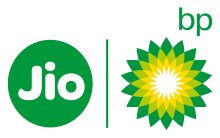Jio-bp
 | |
| Company type | Subsidiary |
|---|---|
| Industry | |
| Founded | 2008 |
| Headquarters | Ahmedabad, Gujarat, India |
Key people | Mukesh Ambani |
| Products | |
| Revenue | |
| Total assets | |
| Parent | Reliance Industries (51%) BP (49%) |
| Website | jiobp |
Jio-bp, or legally Reliance BP Mobility Limited, formally known as Reliance Petroleum is an Indian petroleum company that specializes in oil and energy, owned by Mukesh Ambani of Reliance Industries Limited (RIL), one of India's largest private sector companies. It is based in Ahmedabad, Gujarat, India and has interests in the downstream oil business. RPL was merged with Reliance Industries Limited[2] on 29 September 2009.[3]
Reliance Petroleum and RIL own / have long term chartered two oil rigs – DD KG-1 and DD KG-2 (DD standing for Dhirubhai Deepwater).[4][5][6] They are both drilling ships registered in Marshall Islands and owned by Deepwater Pacific Inc., a subsidiary of Transocean.[7][8][9]
Jamnagar Refinery
With an annual crude processing capacity of 1,240,000 barrels (197,000 m3) per stream day, RPL is the largest refinery in the world. It will have a complexity of 21.0, using the Nelson Complexity Index, ranking it one of the highest in the sector. The polypropylene plant will have a capacity to produce 0.9 million metric tonnes per annum.[citation needed]
The refinery project is being implemented at a capital cost of Rs 270,000 million being funded through a mix of equity and debt. This represents a capital cost of less than US$10,000 per barrel per day and compares very favourably with the average capital cost of new refineries announced in recent years.[citation needed] The International Energy Agency (IEA) estimates the average capital cost of new refinery in the OECD nations to be in the region of US$15,000 to 20,000 per barrel per day.[citation needed] The low capital cost of RPL becomes even more attractive when adjusted for high complexity of the refinery.
Controversies
In 2012, reports surfaced in the media highlighting the fact that ONGC had chartered an oil rig owned by RIL in May 2009 (Dhirubhai Deepwater KG-1, also known as DDKG-1) without taking bids from any other companies.[10] This was revealed in the report published by the Comptroller and Auditor General of India (CAG), the overseer of expenditures of the Indian Government. RIL also owed ONGC Rs. 92,000 crores, which were already overdue by 2 years at that time. However, as of 2018, this outstanding amount was still not paid to ONGC by RIL.[11]
References
- ^ "Reliance AR 2022-23" (PDF).
- ^ "RIL-RPL merger ratio at 1:16". Business Standard. 3 March 2009. Retrieved 2 May 2020.
- ^ "RIL fixes Sept 29 as the record date for RPL merger". The Economic Times. 15 September 2009. Retrieved 2 May 2020.
- ^ "Particulars and fact sheet – Dhirubhai Deepwater KG2" (PDF). deepwater.com. Deepwater Transocean. Retrieved 31 October 2018.
- ^ "Dril lship – Vessel Particulars – DHIRUBHAI DEEPWATER KG1". marinetraffic.com. Marine traffic. Retrieved 31 October 2018.
- ^ "Photograph – DD KG-1". oilrig-photos.com/. Oil rig photos. Retrieved 31 October 2018.
- ^ "Vessel particulars – DD KG-2". vesselfinder.com. Vessel finder. Retrieved 31 October 2018.
- ^ "Transocean's Drillship Sets New Deepest Water Depth Drilling Record". Oil & Energy Today. 18 February 2013. Retrieved 31 October 2018.
- ^ "Deepwater Pacific – Owners information". cn.panjiva.com. Panjiva / S&P Global. Retrieved 31 October 2018.
- ^ Mehdudia, Sujay (8 August 2013). "CAG pulls up ONGC for hiring rig from RIL without bids". The Hindu. Retrieved 31 October 2018.
- ^ "Auditors report" (PDF). tenders.ongc.co.in. ONGC. Retrieved 31 October 2018.
